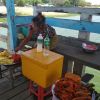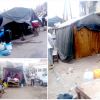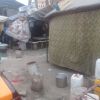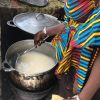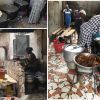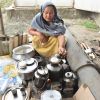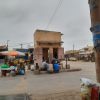The search found 8 results in 0.022 seconds.
Search results
"We used to pack food while wearing gloves but some customers would ask us to take them off and then pack with bare hands," one of the vednor's response to us when we asked her why she didn't wear gloves while packing food.
We were puzzled by this response. Why did the customers ask the vendors to remove their gloves? How did the customers perceive gloves? Is there lack of awareness over hygiene? Do people - vendors and customers- view hygiene differently?
“It seemed that the whole city had turned into a huge market.”
On every street corner various food outlets compete for customers with other types of businesses. Most places have very rudimentary facilities.
"Some have simple tables set out in the open, others stay in the sun while others, like breakfast sellers, join sheets together to make a sort of voting booth in a corner of the street"
On every street corner, too, various street food outlets compete for customers with other types of businesses. These places are either "canteens" or garages of houses transformed into catering spaces with a large table and wooden benches around for customers, or metal or wooden kiosks glued to a wall or by the roadside.
The materials used are numerous: stainless steel or plastic or glass containers, spoons, dishes, a gas bottle or coal furnace, plastic basins for laundry, a few 20-litre oil cans recycled into water reserves and a stack of newspaper used as packaging.
Depending on the time of day, meals with varied menus are served to this very diverse clientele. For breakfast, for example, the saleswomen have bowls on a table, each containing a sauce to make a sandwich, at the customer's discretion, on site or to take away, wrapped in newspaper:
"Arame provides its customers with three long benches. On his table are bowls containing mayonnaise, tuna, pea sauce, spaghetti, French fries, canned meat, ndambé etc. It adds seasonings and spices (chilli, pepper, broth) to foods to suit the taste of customers.
For some vendors the entire preparation chain is a very serious matter, and therefore personal, especially for reasons related to Muslim (halal) precepts:
Bruno to vendor: Are you a Moor?
Vendor: “I am a Pulaar (ethnic group from Senegal) sir, and I am from Lao Air. You can't read? It's nevertheless well written on my beautiful stove! - - aere lao cité baratal fouta toro. ... I know this way of preparing meat better than the Moors. It is a job, like any other, that does not belong to any ethnic group."
Pitha is the common name used in Assam for rice cake. The Boro pitha is traditionally prepared during the harvest festival. In earlier times indigenous varieties of rice were used for making pitha. Each household has its own way of making pitha/ rice cakes and it is generally women who engage in such activities. Now-a-days with indigenous rice varieties slowly disappearing, hybrid rice varieties are used for making pitha; and pitha is no longer related with festivities alone.
La gare routière de Saint-Louis est un lieu oú transitent des centaines de voitures, ainsi que des miliers de personnes. A part les chauffeurs et les passagers, il y'a des employés et des vendeurs qui viennent y travailler tous les jours. Sur notre photo nous voyons, devant le poste de contrôle, six personnes entrain de partager un repas, autour d'un bol. Il y'a parmi eux des coxeurs (hommes qui organisent et tiennent la liste des véhicules et qui sont chargés de rabattre les clients vers un taxi ou un autocar), des agents de la mairie, et des chauffeurs.

